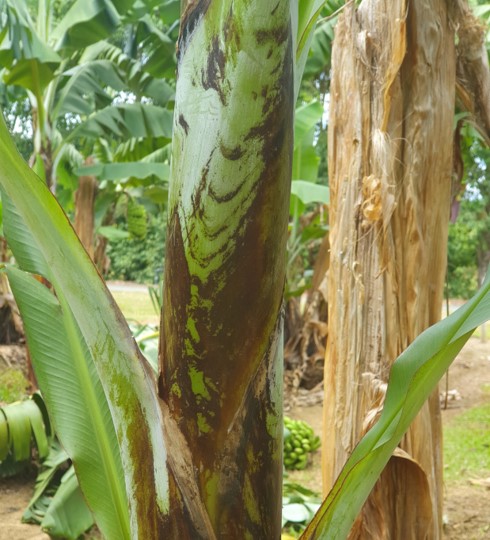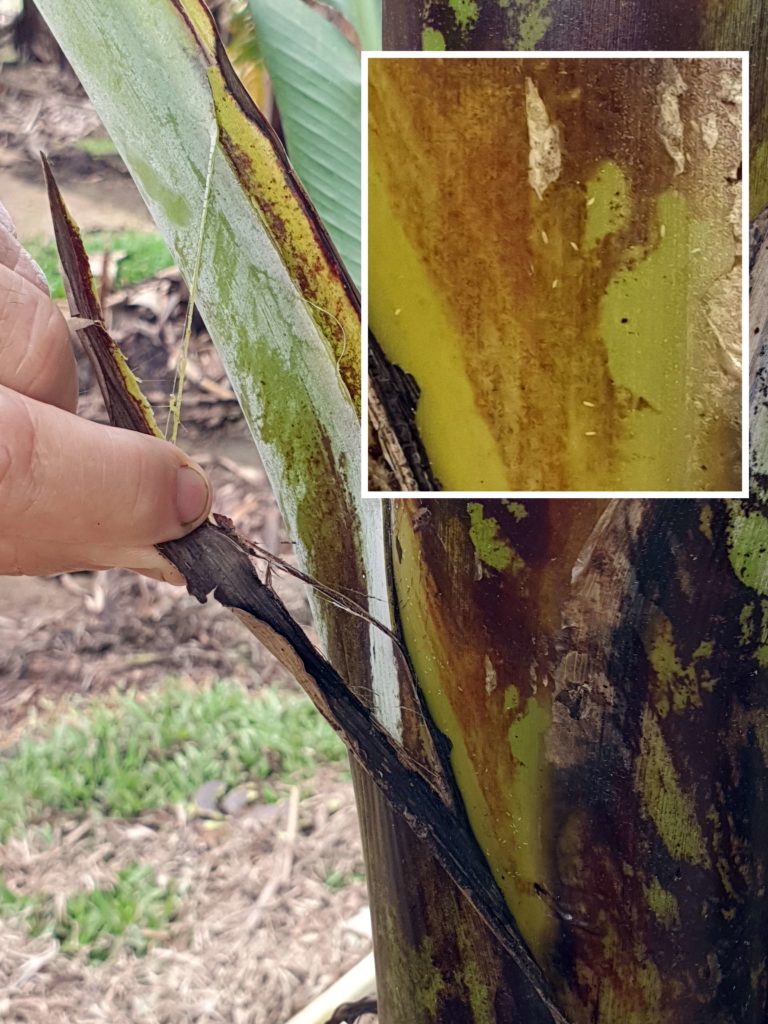Banana rust thrips Chaetanaphothrips signipennis
Monitoring and control options
Monitoring
Rust thrips can occur on unbunched plants and their presence can easily be determined by monitoring established plantations fortnightly throughout the year. New plantings should be inspected prior to bunching in order to determine both the presence and severity of rust thrips infestations so that control measures, if required, can be carried out before fruit damage occurs.
Under heavy infestations, rust thrips can produce characteristic V-shaped rust-coloured markings on pseudostems (Figure 1) as a result of their feeding where the leaf petiole meets the pseudostem. If these markings are observed, the presence of thrips should be confirmed by gently pulling the leaf petioles away from the stem (Figure 2) and inspecting these sites with a 10x hand lens. In addition, it’s advisable to occasionally lift a number of bunch covers and inspect the developing fruit to ensure no thrips or damage are present. If damage has occurred, further damage can be prevented by additional insecticide application, taking care to comply with withholding periods in accordance with the label.

Damage to fingers can range from faint smudge-like markings through to the characteristic slightly red/brown damage known as ‘rust’. Special attention should be paid to those fingers which are closely pressed together as this is where the thrips prefer to feed and shelter.
Control options
Chemical
Chemical control can be directed at both the soil-dwelling pupal stage as well as the adults and larvae on the fruit and plant. Please ensure to always check the Australian Pesticides and Veterinary Medicines Authority (APVMA) website to confirm registration of chemical products before use.
Soil/plant treatments: Apply registered insecticide (e.g. bifenthrin, imidacloprid) as per label directions (e.g. pseudostem treatment, band treatment method). Ensure ground treatments achieve good cover of both the ground around the base of the pseudostem and up the base of the pseudostem as per the label. Treatments aimed at banana weevil borer that are applied to the soil or pseudostem will also provide temporary control of rust thrips. Treatments applied in September/October for weevil borer should provide partial protection, depending on the product used, during November/December and into the early part of the following year.

Fruit treatments: Bell injection is an important component of rust thrips control on the bunch. Correct and timely application is vital for effective control. Apply a registered insecticide (e.g. acephate, spinetoram) as per label or permit directions to the bell in an upright vertical position. Ensure the injector is calibrated and used correctly.
Bunch spraying/dusting at bagging is also an important measure to control rust thrips. Apply a registered insecticide (e.g. chlorpyrifos, spinetoram) as per label or permit directions to the bunch. Ensure the bunch spray/duster is calibrated and used correctly. Bifenthrin impregnated bunch covers can also be used instead of applying insecticides to the bunch as dusts or sprays.
Insecticide resistance can compromise the effectiveness of insecticides, therefore adhering to the label and or permit directions is essential. Endeavour to use chemicals with differing modes of action to minimise the possibility of resistance developing.
Monitoring is important to assess that the applied treatment has been effective.
Cultural
Intact bunch covers (which cover the full length of the bunch) do provide some protection if applied very early. These cannot be relied upon to fully protect the fruit, particularly during severe infestations. Regular checking of fruit under the bunch covers is essential to ensure that damage is not occurring. Ensure treatments are applied immediately after detection to prevent further damage.
Biological
There are currently no specific predators identified which provide a commercial level of control. General predators such as lacewings and ladybird beetles may exert some control of rust thrips on the plant, and ants may be effective in removing some of the pupae in the soil.
For more information contact:
The Better Bananas team
Department of Agriculture and Fisheries
South Johnstone
07 4220 4177 or email betterbananas@daf.qld.gov.au
This information is adapted from: Pinese, B., Piper. R 1994, Bananas insect and mite management, Department of Primary Industries, Queensland
This information has been updated as part of the National Banana Development and Extension Program (BA19004) which is funded by Hort Innovation, using the banana industry research and development levies and contributions from the Australian Government. Hort Innovation is the grower-owned, not-for-profit research and development corporation for Australian horticulture. The Queensland Government has also co-funded the project through the Department of Agriculture and Fisheries.


